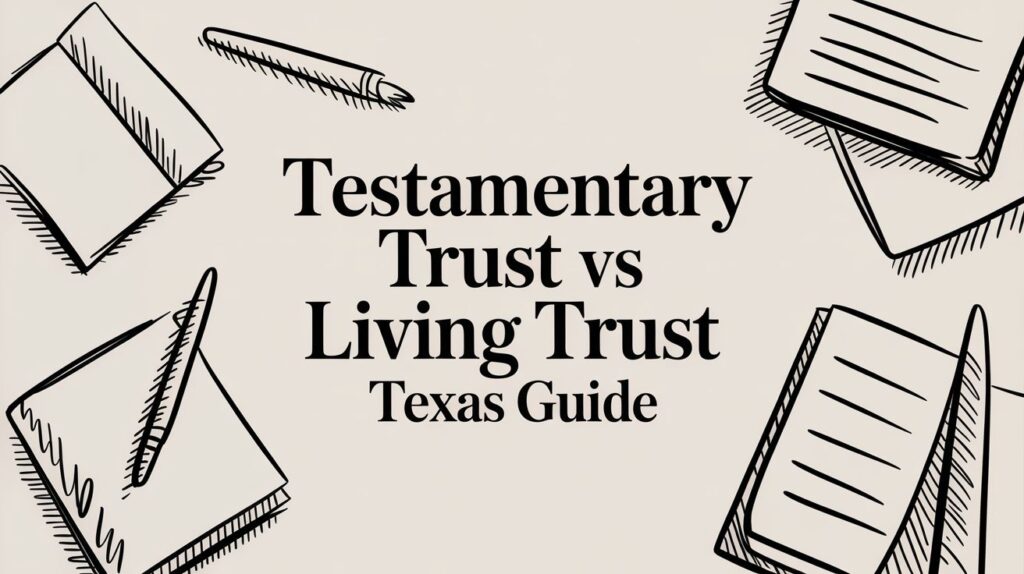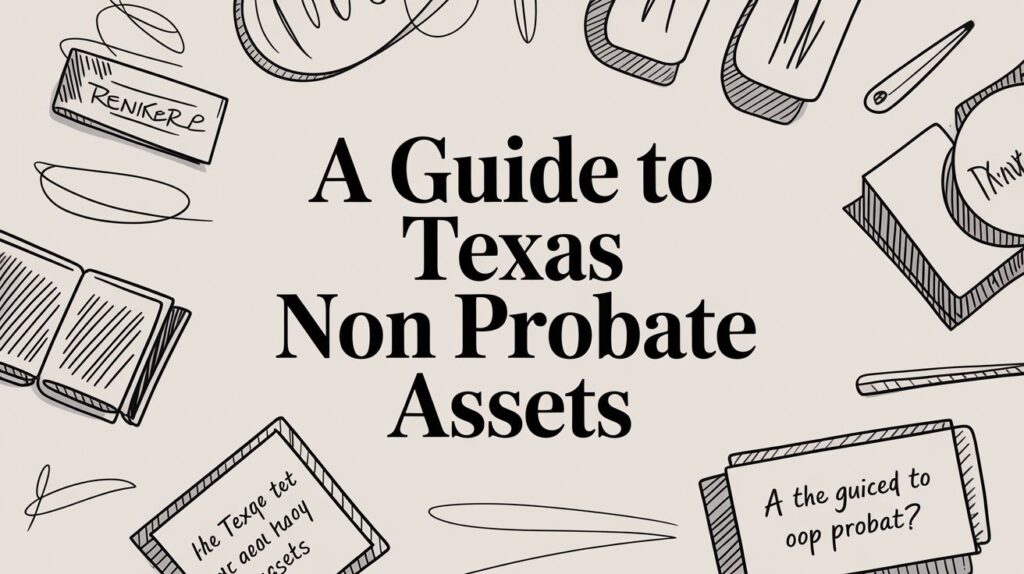Probating a will in Texas yourself can feel like an overwhelming task, but with the right guidance, it is entirely achievable. This article provides a complete breakdown of how to probate a will in Texas yourself, ensuring you save on attorney fees while navigating this legal process with confidence.
What Is Probate and Why Is It Necessary?

Before diving into how to probate a will in Texas yourself, it’s important to understand what probate is. Probate is the legal process of validating a deceased person’s will and distributing their assets according to its terms. This ensures that the decedent’s debts are paid, and their property is allocated to the rightful heirs or beneficiaries.
For example, imagine your late aunt has left behind a will detailing who should inherit her cherished ranch in Texas. Probate ensures that her wishes are legally recognized and that the ranch goes to the right person.
Step 1: Determine if Probate Is Necessary
Not every estate requires probate, and this step is crucial to save time and effort. Texas law provides alternatives such as small estate affidavits for estates valued at $75,000 or less, which can bypass formal probate. The necessity of probate depends on the nature and ownership of the deceased’s assets.
To decide whether probate is needed, ask the following:
- Does the deceased own real estate? If they owned real property solely in their name, probate is likely required to transfer ownership.
- Are the assets held jointly or in a trust? Joint accounts, payable-on-death accounts, or trust-held assets typically do not require probate.
- Is there a valid will? A legally valid will often simplifies probate and outlines the distribution of assets.
If you answered “yes” to these questions or if the estate involves significant assets solely in the deceased’s name, probate is necessary. Conversely, smaller estates with simple arrangements may qualify for streamlined processes. Identifying these details upfront will guide your next steps and ensure compliance with Texas probate laws.
Step 2: Locate and Verify the Will

The next step in probating a will in Texas yourself is to locate the original, signed will—a crucial document required by Texas courts. Start by searching areas where the deceased may have kept important documents, such as safes, filing cabinets, or even digital storage. If the will was stored with an attorney or a financial institution, contact them promptly.
Once you have the original document, verify its validity. Texas law recognizes a will as valid if it meets these criteria:
- Signature of the Deceased: The will must be signed by the testator (the deceased person).
- Two Witnesses: The signatures of at least two witnesses are required, confirming the testator signed the document willingly and with full mental capacity.
- Self-Proving Affidavit: This optional feature streamlines probate by eliminating the need for witnesses to testify in court. It’s a notarized statement attached to the will, confirming its authenticity.
If the original will cannot be found, you may need to pursue probate as if the deceased died intestate (without a will). However, if a copy of the will exists, you can present it to the court and provide evidence to support its validity, though this process may be more complex.
Taking these steps ensures that you have a solid foundation to proceed with probating the will in Texas yourself.
Step 3: File an Application for Probate

In Texas, probate proceedings are handled by the county courts, and filing an application is the formal step to initiate the process. Visit the probate court in the county where the deceased resided, as this will be the jurisdiction for the case. Prepare to file an application for probate, which must include detailed and accurate information. The key components of this application are:
- The Original Will: Ensure the original, signed copy of the will is submitted, as Texas courts typically do not accept photocopies without additional proof.
- A Certified Death Certificate: Obtain this document from the local vital records office to confirm the date and location of death.
- Information About the Decedent: Include their full name, last address, and other identifying details such as the date of death.
- Details About Heirs and Beneficiaries: Clearly list the names, relationships, and contact information of the heirs, as this will help streamline notifications.
Pro tip: File the application within four years of the individual’s death to avoid complications. Missing this deadline can result in losing the ability to probate the will, leaving the estate to be settled under intestacy laws. Once the application is filed, the court will assign a case number and set a hearing date, marking the official start of the probate process. Make sure all details are accurate to prevent delays or rejections.
Step 4: Notify Interested Parties
Once your application is filed, the court will schedule a hearing. During this period, it’s your responsibility to notify all interested parties about the probate proceedings. Interested parties typically include beneficiaries named in the will, potential heirs, and creditors of the deceased. Notifying these parties ensures transparency and gives everyone involved an opportunity to address their claims or concerns.
Methods of Notification:
- Certified Mail: Send notifications via certified mail to beneficiaries and known creditors, ensuring there is proof of delivery.
- Public Notices: If some heirs or creditors are unknown, publish a notice in a widely circulated local newspaper. This public announcement serves as a legal notice and fulfills the court’s requirements for notifying unidentified interested parties.
For example, if the deceased had an outstanding loan with a local bank, that institution must be informed so they can file a claim against the estate if necessary.
Importance of Timely Notification:
Failing to notify all interested parties can delay the probate process and may even result in legal complications. Be diligent about compiling an accurate list of heirs, beneficiaries, and creditors, as this will help avoid disputes or claims of improper notification.
Step 5: Attend the Probate Hearing

At the hearing, the judge will carefully review your application and the accompanying will to ensure everything complies with Texas probate laws. This hearing is a pivotal moment in the probate process, as it determines whether you will be formally appointed as the executor (or administrator, if the will does not name an executor). It’s important to arrive at the hearing fully prepared.
What to Expect at the Hearing:
- Presentation of the Will: You’ll present the original will to the judge, along with the required supporting documents.
- Validation of the Will: The judge will confirm the will’s authenticity, ensuring it meets Texas’ legal requirements, such as valid signatures and witness attestations.
- Appointment of the Executor: If the will is approved, the judge will officially name you as the executor or administrator.
- Questions and Clarifications: Be ready to answer any questions the judge may have about the will, the decedent’s estate, or your qualifications to serve as executor.
Key Responsibilities After Appointment:
Once appointed, you must:
- Take an Oath of Office: This formal pledge confirms your commitment to faithfully execute your duties.
- Post a Bond: Unless the will explicitly waives this requirement, you may need to post a bond to protect the estate against mismanagement.
Tips for Success:
- Dress professionally to demonstrate respect for the court.
- Bring all necessary documents, including the original will, death certificate, and your identification.
- Stay calm and respectful throughout the hearing, even if complications arise.
By being well-prepared and understanding the steps involved, you can ensure the probate hearing runs smoothly, paving the way for the next phases of the probate process.
Step 6: Inventory the Estate
An essential part of how to probate a will in Texas yourself is creating a comprehensive and accurate inventory of the deceased’s assets. This step ensures transparency and accountability, providing the court and beneficiaries with a clear picture of the estate. Your inventory must include the following categories:
Real Estate:
List all properties owned by the deceased, including:
- Primary residences.
- Rental properties.
- Land or undeveloped lots.
Include details like addresses, estimated market values, and whether there are any outstanding mortgages or liens.
Bank Accounts:
Document all bank accounts, specifying:
- Account numbers (last four digits only for privacy).
- Bank names.
- Current balances at the time of death.
Personal Property:
Account for items such as:
- Vehicles: Include make, model, and estimated value.
- Jewelry: Provide appraisals for high-value items.
- Furniture and collectibles: Note items of significant worth or sentimental value.
Debts and Liabilities:
Catalog all known debts, including:
- Credit card balances.
- Loans (personal or business-related).
- Outstanding medical bills or other obligations.
Investment Accounts:
Include information on stocks, bonds, mutual funds, or retirement accounts that are part of the estate.
Special Considerations:
- If there are safety deposit boxes, inventory their contents.
- Include any business interests or ownership stakes in companies.
Once you compile this inventory, you must submit it to the court within 90 days of your appointment as executor. Be thorough and meticulous, as discrepancies can lead to delays or disputes later in the process. Additionally, keep copies of all documents and receipts for your records.
Step 7: Pay Debts and Taxes

Before you can distribute the estate’s assets, it’s crucial to address all outstanding debts and taxes owed by the deceased. This step not only fulfills legal obligations but also protects the executor from potential liability.
Types of Debts to Pay:
- Medical Bills: These might include final hospital or hospice care expenses incurred before death.
- Credit Card Balances: Contact credit card companies to confirm balances and settle accounts.
- Mortgages or Loans: If the deceased had any loans secured by property or other assets, these must be paid off to prevent foreclosure or repossession.
- Utility Bills: Ensure all utility accounts linked to the deceased’s property are cleared or transferred.
Tax Responsibilities:
- Property Taxes: Pay any outstanding property taxes to prevent legal actions against the estate.
- Income Taxes: File the deceased’s final federal and state income tax returns for the year of their death.
- Estate Taxes: Although Texas does not impose state inheritance taxes, federal estate taxes may apply for larger estates exceeding the federal exemption limit.
Steps to Pay Debts and Taxes:
- Notify Creditors: Publish a notice to creditors in a local newspaper as required by Texas law. This allows creditors to file claims within a specified period.
- Review Claims: Evaluate all claims to ensure they are valid. Dispute any questionable claims in court if necessary.
- Use Estate Funds: Pay debts and taxes directly from the estate’s bank accounts. Keep detailed records of all payments, including receipts and canceled checks.
- Obtain Tax Clearance: Request a tax clearance from the IRS once all taxes are paid to confirm compliance.
Avoid Common Pitfalls:
- Overlooking Deadlines: Missing deadlines for tax filings or creditor claims can result in penalties or disputes.
- Using Personal Funds: Do not use your own money to pay the deceased’s debts; always use estate assets.
By prioritizing the settlement of debts and taxes, you pave the way for a smoother process when distributing the remaining assets to beneficiaries.
Step 8: Distribute Assets to Beneficiaries
Finally, distribute the remaining assets according to the will’s instructions. Be meticulous and keep records of all transactions. For example, if the will specifies that a niece inherits a car, ensure the title is legally transferred to her name.
How to Confidently Probate a Will in Texas Yourself
Learning how to probate a will in Texas yourself can save you thousands of dollars while honoring your loved one’s wishes. By following the steps outlined here and staying proactive, you can navigate the probate process with confidence. Remember, every estate is unique, so adapt these guidelines to your specific situation. Armed with this knowledge, you’re well on your way to successfully probating a will in Texas yourself.








